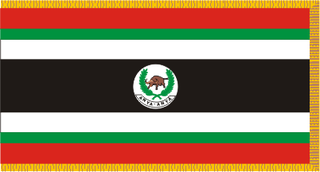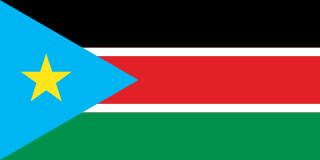
The Bahr el Ghazal is a historical region of northwestern South Sudan. It was dissolved in 2015. Its name came from the river Bahr el Ghazal.

Salva Kiir Mayardit is a South Sudanese politician who has been President of South Sudan since its independence in 2011. He is a Dinka and prior to independence, he was President of the Government of Southern Sudan, as well as First Vice President of Sudan, from 2005 to 2011.

The Anyanya were a southern Sudanese separatist rebel army formed during the First Sudanese Civil War (1955–1972). A separate movement that rose during the Second Sudanese Civil War were, in turn, called Anyanya II. Anyanya means "snake venom" in the Madi language.

Riek Machar Teny Dhurgon is a South Sudanese politician who served as the inaugural Vice President of South Sudan, from its independence in 2011 until his dismissal in 2013. Between April and July 2016 Machar served as the First Vice President of South Sudan. He now leads the rebel faction opposing Salva Kiir known as SPLM-IO.

The SPLA-Nasir was a splinter faction of the Sudan People's Liberation Army (SPLA), a rebel group that fought in the Second Sudanese Civil War. Originally created as an attempt by the Nuer tribe to replace SPLA leader John Garang in August 1991, it gradually became coopted by the government. The break away of Riek Machar from SPLM/A resulted in Nuer ethnic group massacring Garang's ethnic Dinka from Bor in the Bor massacre in 1991. This split resulted in the 1994 National Convention of New Sudan in Chukudum.
Daniel Koat Mathews is a Sudanese politician and Nuer leader, who has been effectively involved in the national politics for many years. He is now a major general in the Sudan People's Liberation Army.

Lieutenant General Nhial Deng Nhial is a South Sudanese politician and a member of the ruling Sudan People's Liberation Movement (SPLM). He was Minister of Foreign Affairs 2011 to 2013 and 2018 to 2019 after having served as the caretaker Minister of Defense since 10 July 2011. Prior to that he served as the pre-independence South Sudanese Minister of SPLA and Veteran Affairs, from 22 December 2008 until 9 July 2011.
Anyanya II is the name taken in 1978 by a group of the 64 tribes of South Sudan dissidents who took up arms in All of Sudan. The name implies continuity with the Anyanya, or Anya-Nya, movement of the First Sudanese Civil War (1955-1972).

Dominic Dim Deng was a senior member of the Sudan People's Liberation Army, a distinguished military veteran General and the first Defence Minister in the Government of Southern Sudan who lost his life alongside his wife Madam Josephine Apieu Jenaro Aken, senior politician Dr. Justin Yac Arop and 18 other Sudan People's Liberation Army and Government of Southern Sudan officials on a leased CEM Air Beechcraft 1900 that crashed 375 km west of Juba, Sudan on May 2, 2008.

The Sudan People's Liberation Army (SPLA) is the army of the Republic of South Sudan. The SPLA was founded as a guerrilla movement against the government of Sudan in 1983 and was a key participant of the Second Sudanese Civil War. Throughout the war, it was led by John Garang.

Southern Sudan was an autonomous region consisting of the ten southern states of Sudan between its formation in July 2005 and independence as the Republic of South Sudan in July 2011. The autonomous government was initially established in Rumbek and later moved to Juba. It was bordered by Ethiopia to the east; Kenya, Uganda, and the Democratic Republic of the Congo to the south; and the Central African Republic to the west. To the north lies the predominantly Arab and Muslim region directly under the control of the central government. The region's autonomous status was a condition of a peace agreement between the Sudan People's Liberation Army/Movement (SPLA/M) and the Government of Sudan represented by the National Congress Party ending the Second Sudanese Civil War. The conflict was Africa's longest running civil war.
Garang Diing Akuong is a South Sudanese politician and diplomat.
Kerubino Kuanyin Bol was one of the leaders of the Sudan People's Liberation Army (SPLA) during the Second Sudanese Civil War (1983-2005). He was said to have fired the first shot in that conflict, which flared up when the Khartoum government of Sudan imposed Muslim Sharia law on the Christian or animist people of South Sudan.

Dr. Lawrence Lual Lual Akuei was a Sudanese politician born in Mathiang-Agor village of Ajak area into a family of spiritual leader Lual Akuei Lual of Pakuein Paan-Deng sub-clan of Agaal-Liil section.
Daniel Awet Akot is the deputy Speaker of the National Legislative Assembly of South Sudan.

Gordon Muortat Mayen Maborjok (1922–2008) was a South Sudanese veteran politician and an advocate for the rights and freedom of the South Sudanese people. He was the President of the Nile Provisional Government (NPG) which led Anyanya I; Southern Sudan's first armed resistance to Khartoum which started in 1955. Muortat also served as Vice-President of the Southern Front (SF) and Foreign Minister in the Southern Sudan Provisional Government (SSPG).

The Dinka–Nuer West Bank Peace & Reconciliation Conference of 1999 was held in what was then the Southern part of Sudan. It is commonly called the "Wunlit Peace Conference" after Wunlit, the village where it was held in eastern Tonj County in Bahr El Ghazal. The conference brought together Nuer from Western Upper Nile and Dinka from Tonj, Rumbek, and Yirol. It is the most prominent and comprehensively documented case of a people-to-people peace process in what is now the Republic of South Sudan.

The South Sudan Patriotic Army is a South Sudanese rebel militia that takes part in the South Sudanese Civil War and serves as military wing of Costello Garang Ring's South Sudan Patriotic Movement. Well armed and relatively numerous, the SSPA mostly operates in Northern Bahr el Ghazal and is considered to be one of the most powerful rebel groups in South Sudan.
The 2014 retreat from Western Bahr el Ghazal, also called the long march north, was an unorganized withdrawal by hundreds of Nuer Sudan People's Liberation Army (SPLA) deserters who sought to flee from Bahr el Ghazal to Sudan during the South Sudanese Civil War. After longstanding tensions between SPLA soldiers belonging to the Dinka and Nuer ethnic groups escalated on 25 April 2014, leading to a massacre of Nuer soldiers at Mapel in Western Bahr el Ghazal, a large number of Nuer SPLA soldiers deserted to escape ethnic prosecution and loyalist SPLA forces. Though some deserters joined SPLM-IO rebels or surrendered to the government, a large number of them marched northward, joined by other SPLA defectors from Northern Bahr el Ghazal. After covering over 400 kilometres (250 mi), this trek eventually arrived in Sudan on 4 August 2014, where they were disarmed.
















